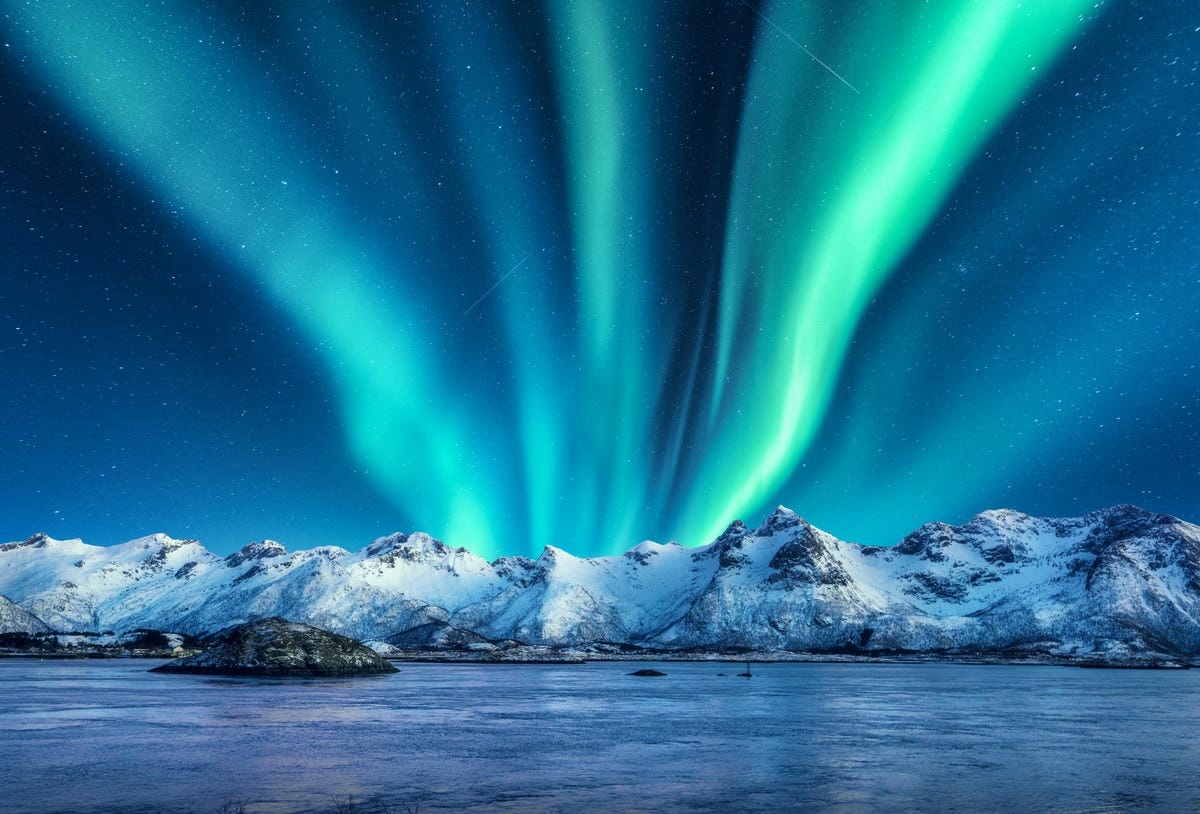
At the beginning we wanted to write a report on the climate situation and the dangers faced by the fauna in the coldest (and most important for the Earth’s ecosystem) area of the planet. We wanted to start with a barbaric slaughter of dolphins and try to explain why nobody does anything about it. But then came the war in Ukraine, and we were forced to analyse one of the fundamental causes of the damage inflicted on the Arctic: the mad push, promoted mainly by Russia and China, for the militarisation of the Pole and the mining exploitation of land no longer covered by eternal ice.
The Arctic is the region to the north of the Arctic Circle, and has its centre in the Arctic Ocean (five times the size of the Mediterranean Sea[1]), surrounded by a belt of landmasses belonging to Russia (which occupies about half the Arctic coastline[2]), Alaska (USA), Canada, Greenland, Iceland and Scandinavia[3]. Four million people live here[4], most of them in Russia[5]. Although the effects of global warming are already tangible[6], the cold is extreme, and a layer of ice covers much of the Arctic Ocean. The day/night alternation is also different: in the period between the spring and autumn equinoxes, when the sun never quite dips below the horizon line, darkness does not come, and there is sunshine at midnight[7]. Six months later, for the opposite reason, the sun never rises[8].
Global warming has more harmful effects in the Arctic than anywhere else on the planet. The average temperature has risen by three degrees from 1971 to 2019[9], forcing animals to change their habitat[10]. Sea ice layers are thinning[11], new animal species are taking up space[12], permafrost is melting, causing problems on land[13], coastal erosion is accelerating[14], and major weather changes are being observed[15]. However, nobody cares. The environmentalists talk about it, but the nations affecting the Arctic are too busy waging a secret and ruthless war, in which the first to die is the continent, its ocean, its fauna and, consequently, everything for which the Arctic is crucial: the survival of life on the planet.
Cold war on the frozen continent
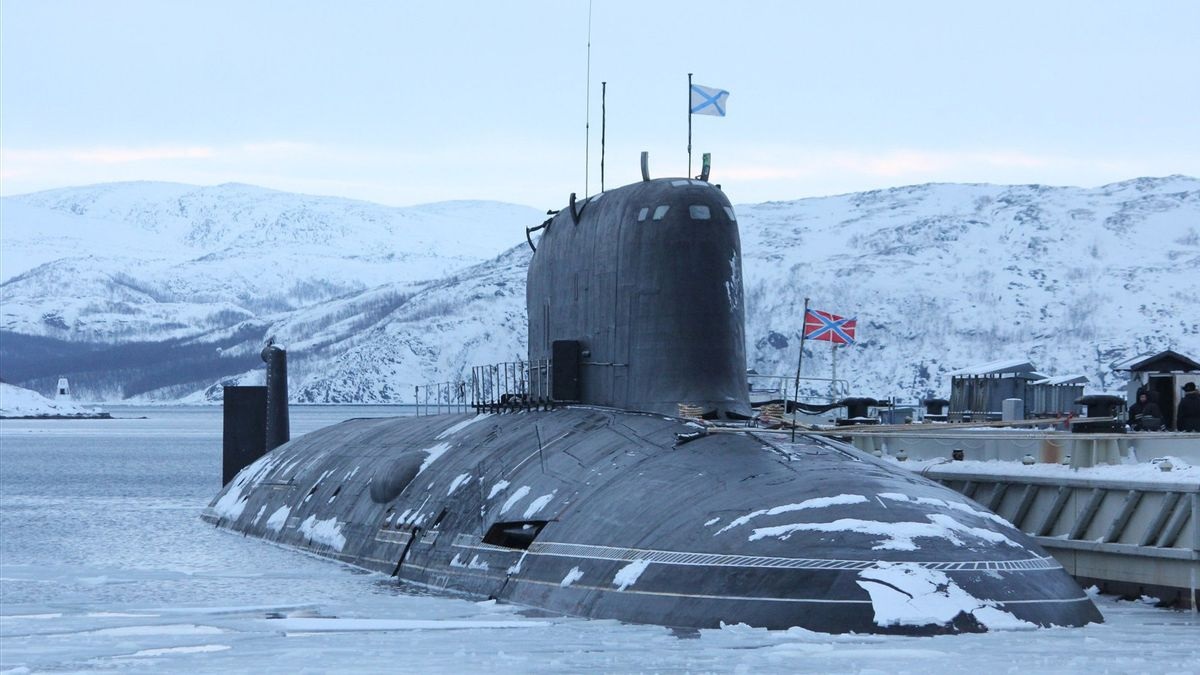
A modern Russian nuclear submarine pulls up to a Norwegian base, just a few hundred metres from where a brand new Russian military installation for war on land and sea is being built[16]
Most of the world’s public opinion considers the North Pole to be inhospitable and useless, and prefers to deal with holidays in the heat rather than endless Arctic nights. But the nations that share it are well aware of the continent’s importance: in March 2021, the US military published ‘Regaining Arctic Dominance’, a document outlining a new military strategy and the reasons for its inevitability[17]. No surprises there. Similar documents had already been published by the Canadian government (2019)[18], the Norwegian government (2020)[19] and the US Navy (2021)[20]. NATO itself has doubled its military activities from 2015 to 2020[21], while Russia has allocated 81% of its maritime nuclear weapons to Northern Fleet submarines[22].
In any case, these are not symptoms of a new phenomenon: the political division of the Arctic was born in blood and violence: this is the case for Canada[23], Denmark[24], the United States[25], Finland, Sweden, Russia[26] and Norway[27]. The original inhabitant states themselves have been at war with each other: the United States against Canada in 1812[28], Norway and Sweden in 1814[29], on both occasions over the exploitation of natural resources and fisheries. In 1940, Germany was more than 50% dependent on iron mined in Sweden and Norway for the transit of a crucial element for war production; the invasion of Denmark and Norway by the Third Reich (Operation Weserübung) was motivated precisely by this dependence[30]. Greenland played a fundamental role in the war: from April 1940, following Operation Weserübung, the island became the site of air bases and an important US meteorological centre to protect the Ivigtut cryolite mine (the only one of its kind in the world[31]), indispensable in the process of extracting aluminium from bauxite, used for military purposes[32]. After Pearl Harbour, the Soviet Arctic ports of Arkhangelsk, Murmansk and Vladivostok were the landing place for Washington’s military supplies to the allies[33].
During the years of the Cold War, the United States and the Soviet Union proceeded to militarise the Arctic[34]: with Soviet nuclear submarines in the base on the Kola peninsula[35] and continuous espionage operations by US nuclear submarines[36]. With the dissolution of the Soviet Union, things improved, not least following Mikhail Gorbachev’s speech on 1 October 1987 in Murmansk, which gave rise to the Murmansk Initiative, which developed a six-point plan[37]: creating a nuclear-free zone in Northern Europe; limiting military activity and scaling down navy and air force activities in the Baltic, North Sea, Norway and Greenland, and promoting confidence-building measures in these areas; cooperating on resource development, including technology sharing; organising an international conference on the coordination of scientific research, leading to an Arctic Research Council; cooperating on environmental protection; and opening the Northern Sea Route to shipping traffic[38].
At the end of the 1980s and the beginning of the 1990s, a climate of political détente favoured arms control and reduction, after the agreements of the 1970s stalled following the Soviet invasion of Afghanistan[39]. The Intermediate-Range Nuclear Forces Treaty (INF Treaty) was signed in 1987[40], the Treaty on Conventional Armed Forces in Europe (CFE) in 1990[41] and the Strategic Arms Reduction Treaty (START I) in 1991[42]: the foundations for a more stable and cooperative world order. Gorbachev’s proposals came to fruition in 1993, when the Barents Euro-Arctic Council (BEAC) was launched, a forum for intergovernmental cooperation on issues concerning the Barents region[43], whose members are Denmark, Sweden, Norway, Finland, Iceland, Russia and the European Union[44]; at the same time, the Barents Regional Council (BRC), a protocol of cooperation signed by the governors of the counties of the Barents region (the north of Finland, Norway and Sweden as well as the Russian northwest) together with representatives of the indigenous peoples, also saw the light of day[45].
The process continued with the Arctic Environmental Protection Strategy (AEPS), also known as the Finnish Initiative – a joint plan to protect the Arctic signed in Rovaniemi on 14 June 1991 in the presence of representatives of the eight Arctic countries[46], which is a milestone in the Arctic ecosystem[47]. From the AEPS, five years later[48], the Arctic Council was born[49], founded on 19 September 1996 in Ottawa[50]. The Arctic Council promotes cooperation, coordination and interaction between Arctic states, Arctic indigenous peoples and other Arctic inhabitants on common issues in the non-military field, particularly on issues of sustainable development and environmental protection[51]. In addition to the eight member states[52] (whose collective consent is required for ratification of each Council decision and statement[53]), six organisations representing indigenous peoples participate in the work of the forum as permanent participants[54].
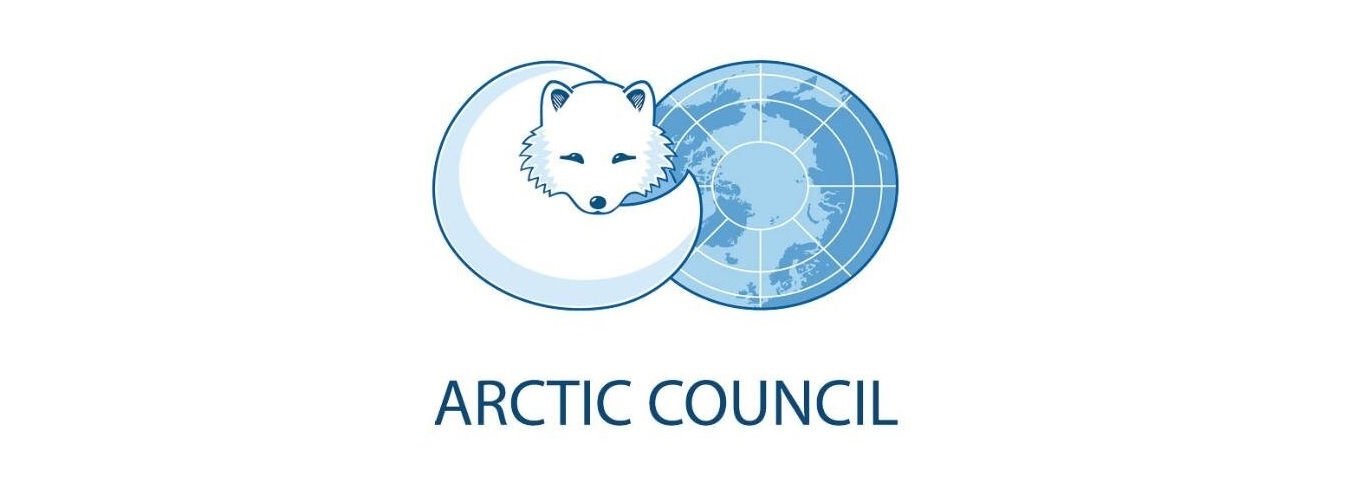
The work of the Council is organised into six Working Groups, which are responsible for implementing the programmes and projects defined by the eight members[55], and whose work is divided as follows: 1. Prevention and reduction of pollution and environmental risks[56]; 2. Measurement and monitoring of the effects of pollution and climate change on ecosystems and human health[57]; 3. Biodiversity conservation[58]; 4. Prevention, preparedness and response to environmental and other emergencies, accidents and search and rescue; 5. Protection and sustainable use of the marine environment; 6. Promotion of sustainable development and improvement of environmental, economic and social conditions of indigenous peoples and Arctic communities[59]. A Group of Experts also participates in the work, periodically assessing progress in controlling coal and natural gas consumption[60]. Over the past 26 years, the Arctic Council has monitored climate change on behalf of the United Nations, the International Maritime Organisation and the UN Framework Convention on Climate Change, while maintaining an open dialogue among member countries and between them and local communities[61].
The period of détente in political relations between the Arctic countries, which began in the 1990s, is mainly due to the state of prostration in which the newly formed Russian Federation finds itself, whose economic and military structure makes the country uncompetitive[62], while the collapse of state and non-state institutions, which began in the late 1980s, contributes to a general situation of chaos[63]. A symptom of this condition is the dissolution of the Red Army in December 1991, when, to the disbelief of the generals in Moscow, local military commanders swear allegiance to the new republics in a climate of general confusion[64]. Many young officers retire from the service and those who decide to stay are often forced to work a second job to make ends meet[65]. The picture of increasing abandonment contributes to the increase of an already existing phenomenon within the Soviet military forces: criminal activity (which grew by 30% between 1991 and 1995[66]), ranging from theft to the misuse of military manpower by officers, abuse, desertion (more than 120 cases per week)[67]. The military decline also involves the Arctic bases (where Moscow historically stored most of its arsenal, nuclear and otherwise[68]), which are largely being abandoned[69].
Russia on its knees did not pose a threat to Washington, and the two States inaugurated a phase of collaboration known as Arctic Exceptionalism[70], during which they also discussed sensitive issues such as the disposal of the large quantity of nuclear fuel contained in the old submarines decommissioned in the Murmansk region[71]. Everything changed in October 1996, when Bill Clinton declared the urgency of extending NATO to countries from the Warsaw Pact[72]. Moscow’s response was not long in coming: Foreign Minister Evgeny Primakov proclaimed his indignation[73], especially since, not even seven years earlier, all Western heads of state had made reassuring declarations about not extending NATO’s borders eastwards[74].
On 12 March 1999, Poland, Hungary and the Czech Republic became NATO members[75]. On 29th March 2004, Bulgaria, Romania, Slovakia, Slovenia, Estonia, Latvia and Lithuania joined[76]: these last three countries are former members of the Soviet Union, and this triggered an angry reaction from the Russian government[77]; General Viktor Zavarzin openly spoke of a threat to national security[78].
In 1994, the Partnership for Peace (PfP) was created, a NATO programme whose aim is to build trust between the Alliance and the countries of the former Soviet Union through joint military exercises[79]. Kazakhstan (1994)[80], Mongolia (2012)[81], Ukraine (1994), Finland (1994) and Sweden (1994)[82] are also part of the PfP, probably contributing to an increase in the sense of encirclement and threat felt by Russia (also a member of the PfP since 1994[83]). From here on, despite the establishment of the NATO-Russia Council in May 2002[84] and the mutual promise not to increase the level of militarisation of the Pole, the time of words begins to give way to that of deeds[85].
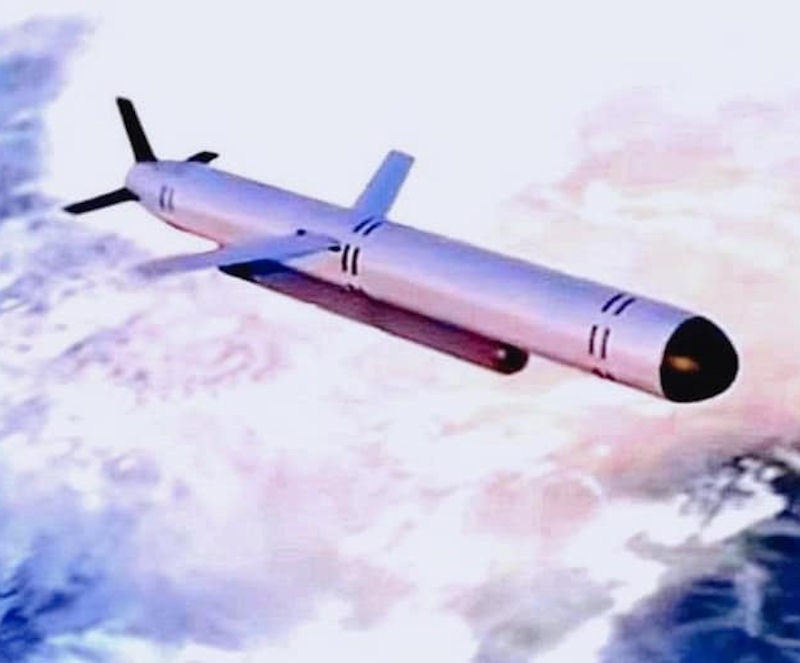
The new 9M730 Burevestnik multiple nuclear warhead missile placed at all Arctic bases[86]
Vladimir Putin, on February 10, 2007, speaks in Munich, on the occasion of the Munich Security Conference[87], and openly criticises the expansion of NATO, branding as unacceptable the situation of substantial US monopoly in global relations and in decisions on strategic balances (such as the invasion of Iraq[88]). Putin asserts that Russia is resuming the independent path to regain the place among the great that it has been denied for too long[89], and returns to Cold War topics[90]. Putin then attacked the European Missile Shield project, commissioned in 2007 by George W. Bush, which consists of a radar station and missile emplacement in the Czech Republic and Poland and is considered a direct threat to Russia[91].
At the same time, Russia announced the success of the first tests of the new RS-24 ballistic missile with multiple warheads, designed to overcome air defence systems such as the European Missile Shield[92], a sign of a line that led Putin, in 2015, to abandon the Treaty on Conventional Arms Control[93]. The RS-24 missile is launched from Nyonoksa[94], in the far northwest, one of the most important military bases of the Russian Navy, near the strategic ports of the Kola Peninsula[95]. On 8 August 2019, at the same base, the nuclear engine of a new missile explodes, killing seven people[96]. The episode brings to the fore a modern rocket called 9M730 Burevestnik[97], as part of a wider programme involving nuclear-powered torpedoes and hypersonic missiles[98] that would be able to shoot down US Navy aircraft carriers by evading the flak of NATO[99] destroyers[100] .
In 2014 came the annexation of Crimea[101] and the start of the conflict in the Donbass[102]. On 1 April, NATO foreign ministers publicly declared their decision to suspend all cooperation activities between the Alliance and Moscow, while maintaining a channel for dialogue within the NATO-Russia Council[103]. Russian naval and aerial military actions in the Baltic region are increasing[104], leading to 40 incidents[105]: the war for the Arctic has officially begun, and the “Regaining Arctic Dominance” is one of its latest chapters[106], as is the first exercise of 8000 soldiers in Alaska in March 2022; dozens of F-35 jets have been transferred there, while the Navy conducts naval and submarine exercises[107]. At stake is not only the danger of being overtaken by Russia[108]: China, which in May 2013 obtained observer status at the Arctic Council[109] and invested from 2005 to 2017 $1.4 billion in the states in the extraction of mineral resources, instils, if possible, even more fear[110].
The looming shadow of the Chinese giant
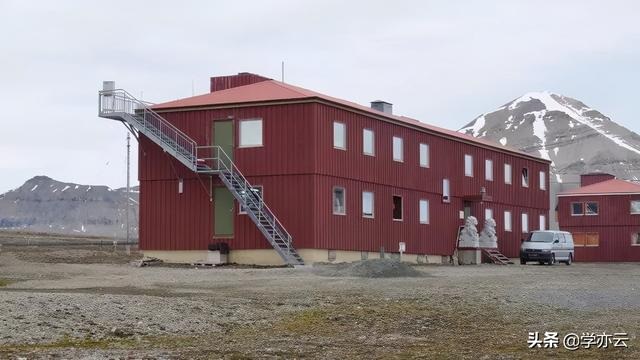
China’s first scientific and military base in the Arctic, in the Svalbard Islands[111]
Long before declaring itself a ‘near-Arctic State’[112], China is embarking on its own path of conquest. China set out on its own path of conquest: Beijing’s path began in 2003, when it established the Yellow River Arctic research base in the Svalbard Islands (Norway)[113], followed by the China Remote Sensing Satellite North Polar Ground Station, a satellite receiving station (the first abroad) operating in Kiruna (Sweden) since 2016[114] and the China-Iceland Arctic Science Observatory, opened in northern Iceland in 2018[115], the same year that an agreement was signed with the Finnish Space and Earth Observation Center to build a research centre in Sodankyla[116]. In 2019 the Chinese sign an agreement with Russia for the construction of the Sino-Russian Arctic Research Center[117], a project in the context of a relationship in which China needs Russia to obtain a privileged entry for the purposes of infrastructural planning of the Polar Silk Road, while Russia supports China to take advantage of its industrial and scientific resources, useful in the study of potential resources in its EEZ (Exclusive Economic Zone) in the Arctic[118].
In 2020 the Arctic Connect project will start, a plan to digitally connect Europe and Asia through an underwater communication cable along the Northern Sea Route. Finland and China are developing it in partnership: the Scandinavians will implement their own data centres, while Beijing will obtain an extraordinary contract for the Huawei Marine platform[119] that, combined with the BeiDou navigation system[120], would allow China to access the sensitive data of consumers and businesses in the countries bordering the ocean[121]. At the same time, Swedish intelligence denounces the strategy of secret Chinese agencies to steal the intellectual property of Swedish start-ups, making it possible to market the relevant technologies first in China than in Sweden[122].
Of particular interest to Beijing is Iceland’s expertise in the field of geothermal energy: in 2012 Orka Energy Holding ehf (Reykjavík) signed a cooperation agreement with the Chinese group Sinopec[123]. In 2018, Iceland’s Arctic Green Energy Corporation and Sinopec obtained a $250 million loan from the Asia Development Bank to develop geothermal resources in China[124]. On the scientific research front, the China-Iceland Arctic Science Observatory opens in 2018 in the north of the island as an aurora borealis observatory, but is later used for research satellite remote sensing, obviously becoming a facility of military significance[125]. A development that frightens the Americans, who are now trying to prevent Iceland from joining the Belt and Road Initiative[126], while China has become one of the top five countries for exports to the island[127].
Russia is also and above all part of Beijing’s plans: Yamal, the largest Chinese investment project in Russia[128], is a Liquefied Natural Gas (LNG) plant in the far north of Siberia, near the Kara Sea[129], costing 27 billion dollars[130] and managed by a consortium in which the Russian gas producer Novatek (50.1%), Total (20%), China National Petroleum Corporation (CNPC) (20%) and Silk Road Fund (9.9%) participate[131]. The plant, which began operating in 2017, processes 16.5 million tonnes of material per year. Three trains are used to transport the gas overland[132], and 15 state-of-the-art icebreakers to transport it by ship[133]. Arctic LNG-2, with a production capacity of 19.8 million tonnes per year, was due to come on stream in 2023. It is owned by Novatek (60%), China National Oil and Gas Exploration and Development Company (CNODC) (10%), China National Petroleum Corporation (CNPC) (10%), Total (10%) and the Mitsui-Jogmec/Japan Arctic LNG consortium (10%)[134] and is located in Gyda, a short distance from Yamal[135]. In March 2022, sanctions against Russia halted the project[136].
In June 2019, China National Chemical Engineering Co. Ltd. (CNCE) signs an agreement with the Russian company NNK-OIL AO to build infrastructure (crude oil processing equipment, a 50-million-tonne-capacity shipping pier, a 750-megawatt-per-year power plant, new pressurised oil transport pipelines[137]) worth $5 billion at the Payakha Oilfield on the Taymyr Peninsula; the Payakha Oilfield is one of the largest oil storage facilities in the Arctic, which can store up to 2 billion tonnes of oil[138]. Work is expected to be completed in 2023[139]. In addition, there is a port near Arkangelsk on the White Sea[140] and a railway linking Arkangelsk with the port of Indiga on the Barents Sea and with Central Asia, so that the new Russian Arctic hub can handle 80 to 200 million tonnes of cargo a year from Kazhakistan, Kyrgyzstan and China[141].
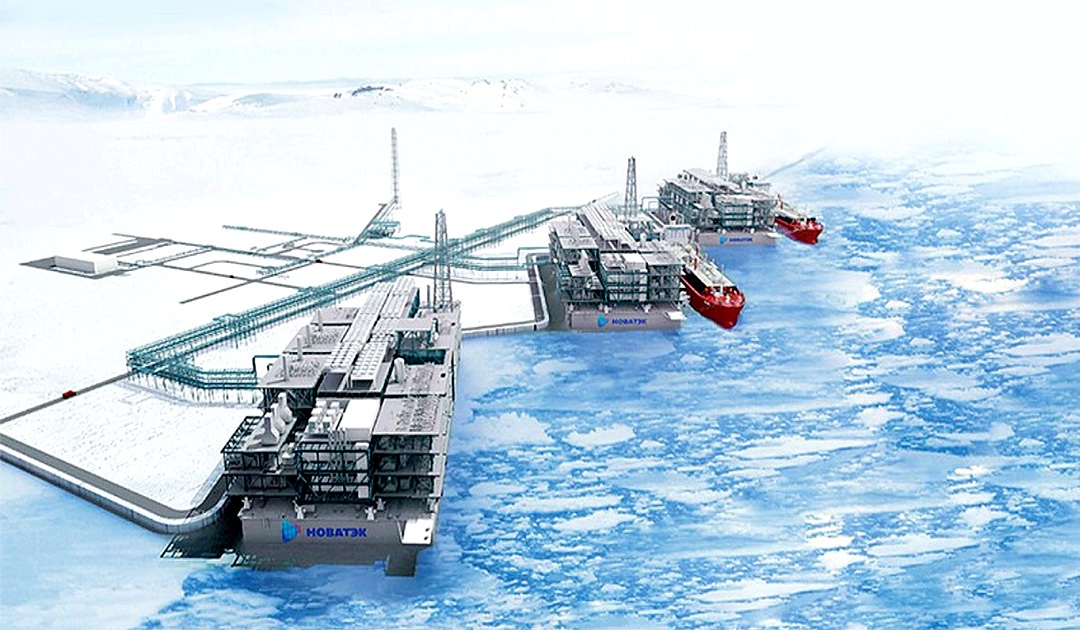
The construction site of the Arctic-LNG-2 gas storage plant on the Gyda Peninsula[142]
Sweden and Finland’s rumoured entry into NATO, in the wake of the continuing crisis in Ukraine, would have the effect of ‘Atlanticising’ the Arctic, with seven out of eight Arctic states being members of the military alliance. Both nations are currently deciding whether to interrupt the traditional neutrality that has characterised their foreign policy since the Second World War: already members of the EU[143] and NATO Enhanced Opportunity Partners[144], the two countries maintain a constant dialogue with Moscow[145], with which relations are not, historically speaking, idyllic[146]. After the 24th of February 2022, however, the Swedish and Finnish public opinion has substantially changed its opinion on a possible request for membership in NATO[147], whose Secretary General, Jens Stoltenberg, foresees a rapid entry of the two countries into the Alliance[148]. The military capabilities of Sweden and Finland would be a valuable addition to the Atlantic defence system, and Scandinavian troops are already trained to operate in climatically hostile territory[149]. Moscow’s reaction: Dmitry Medvedev, vice-president of the Russian Security Council, threatens a further strengthening of land, sea and air forces in the Baltic, and speaks of the return of nuclear warheads to the area[150].
In recent years, Canada, traditionally cautious about strengthening the NATO presence in the far north, also seems to be gradually aligning itself with the trend of a general increase in military activities in the Arctic[151]. A not secondary objective for Ottawa is to make the Northwest Passage a viable route for future maritime transport between the Pacific and Europe[152], as an alternative to the Russian-controlled Northeast Passage (Northern Sea Route)[153]. The scientific community raises doubts as to whether the development of these routes is really worthwhile, as they will only be usable for a few months a year in the foreseeable future, and in a few cases they would actually save time compared to conventional routes[154]. China invested $82 billion in Canada from 2000 to 2020, more than $51 billion of it in oil and gas[155]. However, the volume of these investments has steadily declined due to the deterioration of relations between the two countries following the arrest on fraud charges in December 2018 of Meng Wanzhou, chief financial officer of Huawei[156].
Chinese activities in the Canadian Arctic in the field of commercial exploration can be traced back to the activity of the icebreaker Xuelong, which sailed through the Northwest Passage in 2017, an event that leads to Beijing being considered a growing player as a shipper in the region[157]; although Canadian sovereignty over the Northwest Passage is contested by the United States[158] and not recognised by China, the transit of the Xuelong is agreed with Canadian authorities[159]. The Northern Sea Route is, at the moment, much more used by the Chinese[160], not least because of the incomparably greater amount of Russian-Chinese infrastructure investment, which makes the Northwest Passage far less relevant by comparison[161].
For years, China has been trying to invest in mining projects in Canada: since 2010, the Jilin Jien Nickel Industry has owned Canadian Royalties Inc. (a $192 million operation)[162], operator of a copper and nickel mine in Nunavik[163]. Jinduicheng Molybdenum, instead, acquired Yukon Zinc Corp. in 2008[164], but the company did not take off and went bankrupt in 2019[165]. Chihong Canada Mining, a subsidiary of Yunnan Chihong Zinc & Germanium, in 2010 signed a joint venture with Canada’s Selwyn Resources Ltd. to develop the Selwyn Project, one of the world’s top five undeveloped zinc and lead deposits, located in the Yukon; Yunnan Chihong’s main shareholder is China Yunnan Metallurgical, a company owned by the Yunnan provincial government[166]. In 2016, Selwyn-Chihong suspended plans to develop the mine due to falling metal prices[167], and there has been no news of the project since, as evidenced by the development timeline on the company’s website[168]. This short list shows how the Canadian private sector believes in Chinese investments, carried out by state-owned companies capable of bringing with them an almost unparalleled financial capacity and a solid technical-operational ability; the ability to achieve the objectives must, however, clash not only with a climatically unfavourable environment, in which operations are difficult, but also with scarce or non-existent infrastructures, factors that considerably increase the rate of risk for the companies[169], as well as with the growing diffidence of the Ottawa government towards the real Chinese intentions[170].
The conquest of Arctic fields
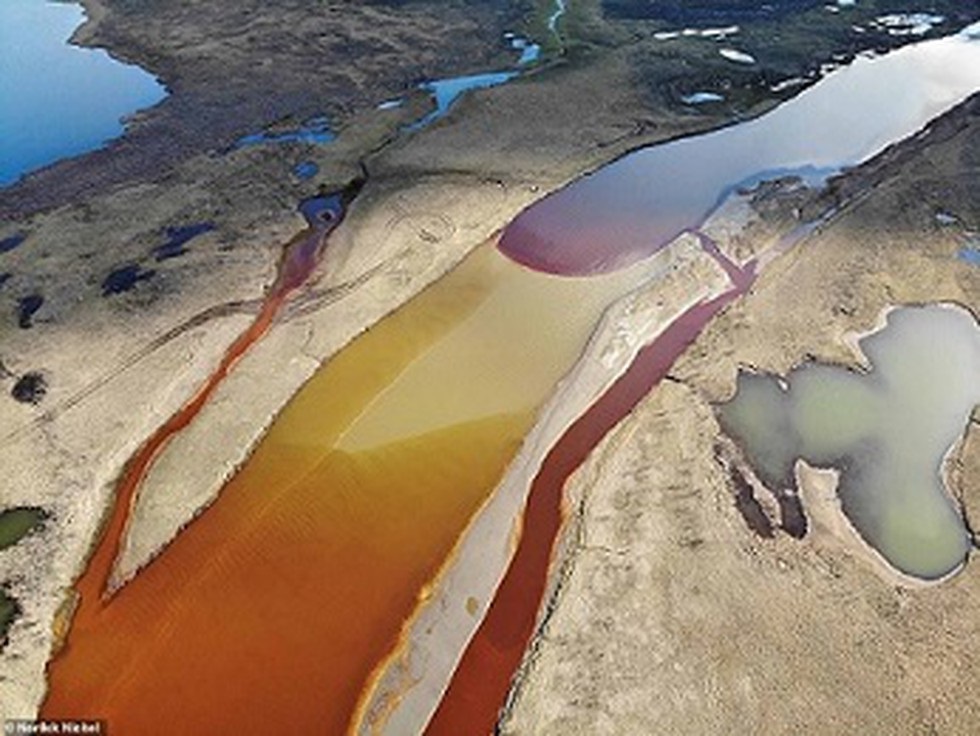
Due to thawing permafrost, some infrastructures become unstable. A diesel tank at a power station in Noril’sk cracked, poisoning the Ambarnaya River for decades[171]
Climate change is making it easier to access the area’s resources: hydrocarbons (oil, gas and coal), minerals (rare earths, uranium)[172]; in addition, technological progress is making it possible to face challenges that were once unthinkable[173] and requires the finding of those resources, such as rare earths, that are indispensable for the mass production of high-tech green products[174]. Rising temperatures are making the Arctic Ocean navigable[175], reducing sailing times between China and New York by seven days, making part of the Arctic routes attractive for tourism and commercial shipping[176].
At the same time, however, some resources are becoming less accessible: the permafrost, which is melting, is causing environmental disasters in the Russian far north, as in the case of the city of Noril’sk, where in May 2020 the tanker of a power station lost about 20,000 tonnes of diesel, which poured into the Ambarnaya River[177]. The company NTEK AO, a subsidiary of the Nornickel Group, which operates the plant, blames the disaster on the melting of the permafrost, on which the foundations of the structure are built, which are sinking[178]. The difficulties of extracting resources and building storage and transport facilities for materials on unstable ground are driving up costs for companies enormously[179]. While other countries think in terms of the environment, Moscow links industrial supremacy to military supremacy, and these two reasons trump all other considerations[180].
Is it worthwhile for Russia to invest in hydrocarbons in the Arctic at a time when the West is increasingly focusing on ending the era of oil, gas and coal? What market will these resources, which Moscow is preparing to extract for decades, have in a world that will use them less and less[181]? Already today, the European market, thanks to the Ukrainian crisis, is gearing up in a hurry to find alternatives[182], while the Asian market is problematic from a logistical point of view: ships have to travel thousands of kilometres to get around the enormous Russian northeast without an adequate infrastructure network capable of providing support to ships in case of need (breakdowns, accidents). It is difficult to understand to whom these resources will be sold in such quantities as to justify the huge investments needed to make them available[183].
This military competition seems to be an attempt to reassert its role among the superpowers, rather than an economic move. In support of this thesis are also the Russian claims on portions of the Arctic Ocean seabed submitted in February 2016[184] and April 2021 to the United Nations, the second of which concerns an extension to the marine areas of Canada and Greenland[185]. It is noteworthy that Denmark and Canada have also submitted claims on parts of the sea[186]; in all three cases these converge towards the North Pole, reflecting the strong symbolic value this would bring. Again, it is difficult to understand the economic advantage in the race for that stretch of seabed, which is extremely distant from the coasts: no company specialised in the extraction of submarine deposits could undertake such a venture in the middle of the Arctic Ocean[187].
The parallel universe: the Artic Council
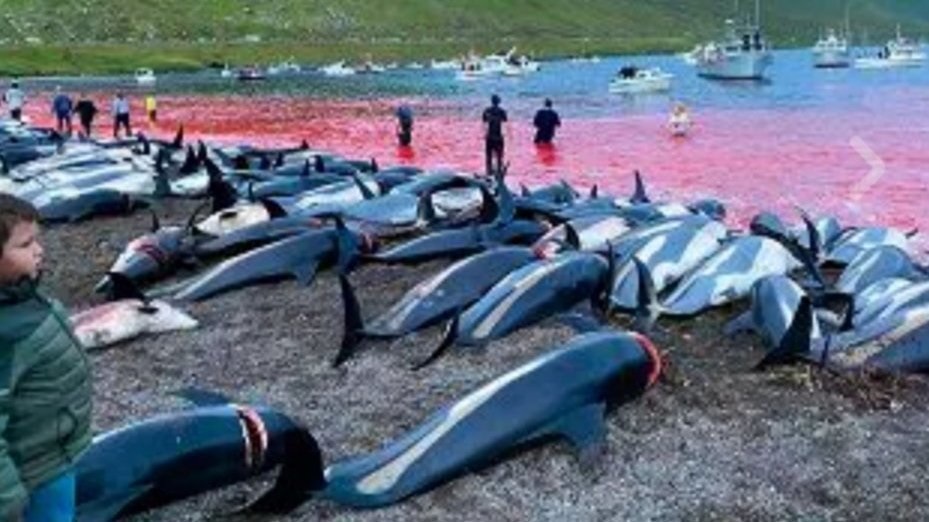
Blood-stained sea after 2021 dolphin slaughter[188]
The Artic Council is the forum created to deal with non-military issues, such as climate change and the exploitation of natural resources; Russia, which takes over the presidency in 2021 for the next two years[189], appears to be much more cooperative here than it actually is outside it, at least until the start of the Ukraine crisis with the consequent suspension of the Council’s activities. This stance of the other seven member Countries could induce Moscow, which intends to continue with its own path of economic-military development, to involve, more directly, new non-arctic partners besides China: India[190], the members of the ASEAN (Association of South-East Asian Nations) and the United Arab Emirates[191]. The difficulty in devising an effective and unified strategy for the Arctic has been one of the responsibilities of the United States for the past ten years[192]. Washington’s response is limited to military documents: in 2019 the Secretary of Defence chose a strategic charter[193]; shortly afterwards the Air Force[194], Navy[195] and Army[196] did the same, but lacked a common vision and coordination[197]. The winds of war are wiping everything else off the international diplomatic agenda[198]. Russia has gradually become scary again[199], for example with GPS jamming, a system that creates problems for pilots of military and non-military aircraft flying over the Finnmark area in the far north of Norway[200]. In that area, which includes the Barens Sea and the North Sea, Russia is carrying out military exercises and operations (including some submarine ones) as it did during the Cold War[201]; NATO’s response is the large-scale ‘Cold Response’ exercise, which will take place on 25 March 2022 with the participation of Sweden and Finland[202].
In all this militaristic fervour, the agreement signed in 1973 between the United States, the Soviet Union, Norway, Canada and Denmark, called the Agreement on the Conservation of Polar Bears, to preserve polar bears, seems like a sad joke[203], thinking of the terrible massacre at Skálabotnur on the island of Eysturoy, in the Faeroe Islands (Denmark), where the inhabitants, as part of an annual whaling festival, barbarously and disgustingly killed 1500 dolphins[204]. Just for the fun of it. Despite the large number of commitments made at international symposia on the priority given to environmental protection and cooperation in the region, which have, despite everything, led to progress in focusing on primary objectives, the directions in which the major powers are moving their investments tell a different story.
People care little about the North Pole, they do not understand its importance, while diplomacy, for decades, has been trying to avoid the worst, and has been doing so in the total silence of the world’s media. All this until 24 February 2022: since then, unfortunately, all channels of communication have been cut off, and the winds of war are blowing ever further north.
[1] https://www.britannica.com/place/Arctic-Ocean
[2] https://arctic-council.org/about/states/russian-federation/#:~:text=Russia%20stretches%20over%2053%20percent,living%20in%20the%20Arctic%20worldwide.
[3] https://www.sciencedirect.com/topics/social-sciences/arctic-ocean
[4] https://nsidc.org/cryosphere/arctic-meteorology/arctic-people.html
[5] https://arctic-council.org/about/states/russian-federation/#:~:text=Russia%20stretches%20over%2053%20percent,living%20in%20the%20Arctic%20worldwide.
[6]https://arcticwwf.org/work/climate/#:~:text=Without%20urgent%20action%20to%20cut,stocks%2C%20birds%20and%20marine%20mammals.
[7] https://oceanwide-expeditions.com/blog/light-in-the-land-of-the-midnight-sun
[8] https://arctic-council.org/news/arctic-residents-cozy-up-during-the-polar-night/
[9] https://phys.org/news/2021-05-arctic-faster-planet.html
[10] https://www.sciencedaily.com/releases/2021/09/210914110258.htm
[11] https://arctic.noaa.gov/Report-Card/Report-Card-2021/ArtMID/8022/ArticleID/945/Sea-Ice
[12] https://www.caff.is/climate-change-squeezing-arctic-animals-and-plants-new-circumpolar-report-may-20-2021
[13] https://earthsky.org/earth/permafrost-thaw-in-the-arctic-in-the-next-30-years/
[14] https://www.nature.com/articles/s41558-022-01281-0
[15] https://www.greenfacts.org/en/arctic-climate-change/l-3/2-polar-ice-cap-melting.htm
[16] https://voi.id/en/news/92208/after-ultra-modern-military-base-russia-will-build-a-naval-fleet-in-the-arctic
[17] https://api.army.mil/e2/c/downloads/2021/03/15/9944046e/regaining-arctic-dominance-us-army-in-the-arctic-19-january-2021-unclassified.pdf
[18] https://www.rcaanc-cirnac.gc.ca/eng/1562939617400/1562939658000
[19] https://www.rcinet.ca/eye-on-the-arctic/2020/04/20/norway-strengthens-its-arctic-military-in-new-defense-plan-as-security-concerns-grow-in-the-region/
[20] https://www.navalnews.com/naval-news/2021/02/u-s-navy-reports-on-arctic-and-north-atlantic/
[21] https://sputniknews.com/20200522/nato-doubled-military-activity-in-arctic-region-in-past-5-years-russian-diplomat-says-1079391100.html
[22] https://icds.ee/en/russias-military-capabilities-in-the-arctic/
[23] https://earlycanadianhistory.ca/2020/11/23/settler-colonial-violence-and-the-maritime-fisheries/
[24] https://ibiworld.eu/en/greenland-humanitys-new-promised-land/
[25] https://journals.openedition.org/angles/1313 ; https://www.humanrightspulse.com/mastercontentblog/the-deafening-silence-on-the-massacre-of-native-women-in-the-united-states-of-america
[26] https://blogs.helsinki.fi/nordic-colonialism/files/2021/05/NordicColonialism_Workshop1_ABSTRACTS.pdf
[27] https://blogs.prio.org/2018/05/norway-the-colonial-power/
[28] https://www.politico.com/magazine/story/2018/06/21/that-time-the-us-almost-went-to-war-with-canada-218881/
[29] https://www.napoleon-series.org/military-info/battles/1814/c_norway1814.html
[30] https://www.chemeurope.com/en/encyclopedia/Swedish_iron_ore_during_World_War_II.html
[31] https://www.mindat.org/loc-1958.html
[32] https://ibiworld.eu/en/greenland-humanitys-new-promised-land/
[33] https://notevenpast.org/lend-lease/
[34] https://storymaps.arcgis.com/stories/a19b6a79bc5c4596b52531856af389c9
[35] Siegfried Breyer, “Kola-Halbinsel: Stärkste F1otterbasis der Sowjetunion”, Soldat und Technik, n° 1, 1978, pp.30-37
[36] https://nationalinterest.org/blog/reboot/how-american-submarines-spied-soviet-union-years-193428
[37] https://www.barentsinfo.fi/docs/Gorbachev_speech.pdf
[38] https://www.adn.com/arctic/article/how-gorbachev-shaped-future-arctic-policy-25-years-ago/2012/10/01/
[39] https://history.state.gov/milestones/1969-1976/salt
[40] https://www.armscontrol.org/factsheets/INFtreaty
[41] https://www.nti.org/education-center/treaties-and-regimes/treaty-conventional-armed-forces-europe-cfe/
[42] https://www.nps.gov/articles/start-treaty-1991.htm#:~:text=The%20Strategic%20Arms%20Reduction%20Treaty,warheads%20either%20country%20could%20possess.
[43] https://www.barents-council.org/barents-euro-arctic-council
[44] https://www.barents-council.org/barents-euro-arctic-council/members-of-the-beac-and-the-brc
[45] https://www.barents-council.org/barents-regional-council
[46] http://library.arcticportal.org/1542/1/artic_environment.pdf
[47] http://library.arcticportal.org/1542/1/artic_environment.pdf
[48] https://www.uarctic.org/shared-voices/shared-voices-magazine-2016-special-issue/it-all-started-in-rovaniemi/
[49] https://arctic-council.org/about/timeline/#:~:text=On%20September%2019%2C%201996%20in,inhabitants%20on%20common%20Arctic%20issues
[50] https://oaarchive.arctic-council.org/bitstream/handle/11374/85/EDOCS-1752-v2-ACMMCA00_Ottawa_1996_Founding_Declaration.PDF?sequence=5&isAllowed=y
[51] https://arctic-council.org/about/
[52] https://arctic-council.org/about/states/
[53] https://arctic-council.org/about/
[54] https://arctic-council.org/about/permanent-participants/
[55] https://arctic-council.org/about/working-groups/
[56] https://arctic-council.org/about/working-groups/acap/
[57] https://arctic-council.org/about/working-groups/amap/
[58] https://arctic-council.org/about/working-groups/caff/
[59] https://arctic-council.org/about/working-groups/sdwg/
[60] https://arctic-council.org/about/task-expert/egbcm/
[61] https://arctic-council.org/news/reflections-on-the-past-and-future-of-the-arctic-council/
[62] https://thewire.in/economy/post-soviet-russian-economic-collapse
[63] https://unctad.org/system/files/official-document/poirrsd002.en.pdf
[64] https://nuke.fas.org/guide/russia/agency/Felg.htm
[65] http://www.historyofwar.org/articles/weapons_russianarmy1990.html
[66] T. R. W. Waters, “Crime in the Russian Military”, Research Paper C90, CSRC (RMA Sandhurst), November 1996, p. 2
[67] Benjamin S. Lambeth, “Russia’s Wounded Military,” Foreign Affairs 74, no.2, March–April 1995, p. 90
[68] https://www.interactioncouncil.org/publications/proposal-arctic-nuclear-weapon-free-zone
[69] https://www.thearcticinstitute.org/why-military-security-should-be-kept-out-of-the-arctic-council/
[70] https://transatlanticrelations.org/wp-content/uploads/2020/12/The-Arctic-and-World-Order-ch14.pdf
[71] https://link.springer.com/chapter/10.1007/1-4020-4173-X_11
[72] https://www.nytimes.com/1996/10/23/us/clinton-urges-nato-expansion-in-1999.html
[73] https://nsarchive.gwu.edu/briefing-book/russia-programs/2018-03-16/nato-expansion-what-yeltsin-heard
[74] https://nsarchive.gwu.edu/briefing-book/russia-programs/2017-12-12/nato-expansion-what-gorbachev-heard-western-leaders-early
[75] https://warsawinstitute.org/accession-poland-czech-republic-hungary-nato/
[76] https://www.nato.int/docu/update/2004/03-march/e0329a.htm#:~:text=NATO%20Update%3A%20Seven%20new%20members%20join%20NATO%20%2D%2029%20March%202004&text=On%2029%20March%2C%20Bulgaria%2C%20Estonia,with%20the%20United%20States%20Government
[77] https://www.nytimes.com/2004/04/03/world/as-nato-finally-arrives-on-its-border-russia-grumbles.html
[78] R. G. Gidadhubli, “Expansion of NATO: Russia’s Dilemma”, Economic and Political Weekly, vol. 39, no. 19, 2004, p. 1885
[79] https://1997-2001.state.gov/regions/eur/nato_fs-pfp.html
[80] https://www.nato.int/cps/en/natohq/news_113927.htm?selectedLocale=en
[81] https://www.nato.int/cps/en/natohq/topics_85297.htm
[82] https://www.nato.int/cps/en/natolive/topics_82584.htm
[83] https://www.nato.int/cps/en/natolive/topics_82584.htm
[84] https://apps.dtic.mil/sti/citations/ADA417702
[85] https://www.nato.int/nrc-website/en/about/index.html
[86] https://www.globalsecurity.org/wmd/world/russia/krnd.htm
[87] https://www.youtube.com/watch?v=hQ58Yv6kP44
[88] https://www.washingtonpost.com/news/worldviews/wp/2014/06/12/russia-on-iraq-we-told-you-so/
[89] https://russialist.org/transcript-putin-speech-and-the-following-discussion-at-the-munich-conference-on-security-policy/
[90] https://www.politico.com/news/magazine/2022/02/18/putin-speech-wake-up-call-post-cold-war-order-liberal-2007-00009918
[91] https://www.npr.org/templates/story/story.php?storyId=15674582&t=1648939810808
[92] https://www.dw.com/en/putin-lashes-out-at-us-eu-as-russia-tests-missile/a-2568491
[93] “Russia, arms control and non-proliferation” Briefing, European Parliament, European Union, 2020, p.5 https://www.europarl.europa.eu/RegData/etudes/BRIE/2020/652100/EPRS_BRI(2020)652100_EN.pdf
[94] https://www.dw.com/en/putin-lashes-out-at-us-eu-as-russia-tests-missile/a-2568491
[95] https://www.fpri.org/article/2019/08/what-happened-at-the-severodvinsk-naval-testing-range-thoughts-on-the-severodvinsk-radioactive-release-and-when-it-happened-here/
[96] https://www.nytimes.com/2019/08/12/world/europe/russia-nuclear-accident-putin.html
[97] https://arstechnica.com/information-technology/2019/08/russian-nuclear-powered-cruise-missile-blows-up-creating-mini-chernobyl/
[98] https://arstechnica.com/tech-policy/2018/03/putin-boasts-new-strategic-weapons-will-make-us-missile-defense-useless/
[99] https://obamawhitehouse.archives.gov/the-press-office/fact-sheet-us-missile-defense-policy-a-phased-adaptive-approach-missile-defense-eur
[100] https://arstechnica.com/tech-policy/2018/03/putin-boasts-new-strategic-weapons-will-make-us-missile-defense-useless/
[101] https://www.cnbc.com/2022/01/27/how-russia-invaded-ukraine-in-2014-and-how-the-markets-tanked.html
[102] https://www.crisisgroup.org/content/conflict-ukraines-donbas-visual-explainer
[103] https://www.bbc.com/news/world-europe-26838894
[104] https://www.bbc.com/news/world-europe-30429349
[105] Thomas Frear, Łukasz Kulesa, Ian Kearns, “Dangerous Brinkmanship: Close Military Encounters Between Russia and the West in 2014”, European Leadership Network, November 2014, p.2
[106] https://api.army.mil/e2/c/downloads/2021/03/15/9944046e/regaining-arctic-dominance-us-army-in-the-arctic-19-january-2021-unclassified.pdf
[107] https://www.nytimes.com/2022/03/27/us/army-alaska-arctic-russia.html?searchResultPosition=1
[108] https://www.csis.org/features/ice-curtain-russias-arctic-military-presence
[109] Sanna Kopra, “China’s Arctic Interests”, Arctic Yearbook 2013, p. 4
[110] https://www.repubblica.it/green-and-blue/2022/04/05/news/artico_ambiente_guerra_ucraina-344129978/?ref=RHTP-BI-I341903307-P9-S4-T1
[111] https://daydaynews.cc/en/science/a-big-pie-in-the-sky-how-did-my-countrys-arctic-yellow-river.html
[112] https://www.clingendael.org/pub/2020/presence-before-power/2-presence-before-power-why-china-became-a-near-arctic-state/
[113] https://www.thearcticinstitute.org/countries/china/
[114] https://www.chinadaily.com.cn/china/2016-12/16/content_27687937.htm
[116] https://scandasia.com/china-and-finland-to-increase-arctic-research-coorporation/
[117] US Department of Defence, “Military and Security Developments Involving the People’s Republic of China 2020” – Annual Report to Congress, p. 133
[118] https://www.highnorthnews.com/en/russian-and-chinese-scientists-establish-arctic-research-center
[119] https://icds.ee/en/handing-over-infrastructure-for-chinas-strategic-objectives-arctic-connect-and-the-digital-silk-road-in-the-arctic/
[120] https://thediplomat.com/2021/04/chinas-digital-silk-road-and-the-global-digital-order/
[121] https://www.recordedfuture.com/china-digital-colonialism-espionage-silk-road/
[122] Heather A. Conley, James A. Lewis and Max Shafron, “China’s Nordic Investment Hub: The Case of Sweden”, in Chinese Technology Acquisitions in the Nordic Region, Center for Strategic and International Studies (CSIS), 2020, p. 7
[123] https://www.thinkgeoenergy.com/icelandic-orka-energy-to-collaborate-more-closely-with-sinopec-on-geothermal-development/
[124] https://thediplomat.com/2015/05/china-iceland-and-the-arctic/ ; https://www.reuters.com/article/us-china-pollution-heating-idUSKBN1GY0CP
[125] https://www.arctictoday.com/new-china-iceland-arctic-science-observatory-already-expanding-focus/
[126] https://www.mfa.gov.cn/ce/ceis//eng/zbgx/rwjl/t1536495.htm ; https://www.isdp.eu/pressure-in-the-arctic-china-iceland-relations/
[127] https://wits.worldbank.org/CountryProfile/en/Country/ISL/Year/2019/Summary
[128] https://www.cnpc.com.cn/en/csr2014enhms/201807/771c0549950f4420ad6de3972fe27073/files/88c8e515fb734e6984ef3599ab2255c2.pdf
[129] https://www.hydrocarbons-technology.com/projects/yamal-lng-project-russia/
[130] http://oilprice.com/Energy/Energy-General/Putin-May-Have-Last-Laugh-Over-Western-Sanctions.html
[131] https://totalenergies.com/media/news/press-releases/russia-yamal-lng-starts-train-3-twelve-months-ahead-schedule-and-achieves-its-full-capacity
[132] https://totalenergies.com/media/news/press-releases/russia-yamal-lng-starts-train-3-twelve-months-ahead-schedule-and-achieves-its-full-capacity
[133] https://gcaptain.com/yamal-lngs-15-vessel-fleet-of-icebreaking-lng-tankers-now-operational/
[134] https://totalenergies.com/media/news/press-releases/russia-launch-giant-arctic-lng-2-development
[135] https://www.nsenergybusiness.com/projects/arctic-lng-2-project/
[136] https://thebarentsobserver.com/en/2022/03/russias-grand-arctic-lng-project-might-come-halt
[137] http://www.sasac.gov.cn/n2588025/n2588124/c11445784/content.html
[138] https://www.yicaiglobal.com/news/chinese-soe-mucks-in-on-infrastructure-for-russia-payakha-oilfield
[139] http://www.sasac.gov.cn/n2588025/n2588124/c11445784/content.html
[140] https://thebarentsobserver.com/en/industry-and-energy/2016/10/new-mega-port-arkhangelsk-chinese-investments
[141] https://thebarentsobserver.com/en/arctic/2020/05/new-barents-sea-port-will-get-railway-connecting-asia-arctic
[142] https://polarjournal.ch/2021/09/15/indien-moechten-sich-an-arctic-lng-2-beteiligen/
[143] https://european-union.europa.eu/principles-countries-history/country-profiles_en?page=1
[144] https://www.nato.int/cps/en/natohq/topics_132726.htm#:~:text=As%20a%20result%20of%20the,%2C%20Jordan%2C%20Sweden%20and%20Ukraine
[145] https://www.npr.org/2022/03/03/1084112625/neutral-finland-sweden-warm-to-idea-of-nato-membership
[146] https://www.trtworld.com/magazine/a-look-into-sweden-and-finland-s-russia-policy-56388
[147] https://yle.fi/news/3-12357832 ; https://www.thelocal.se/20220324/six-out-of-ten-swedes-would-back-nato-if-finland-joined-poll/ ; https://www.reuters.com/world/europe/finland-sweden-weigh-up-pros-cons-nato-membership-2022-04-13/
[148] https://www.nato.int/cps/en/natohq/opinions_194326.htm
[149] https://www.rand.org/blog/2022/03/complex-but-promising-prospects-as-finland-and-sweden.html
[150] https://www.reuters.com/world/europe/russia-warns-baltic-nuclear-deployment-if-nato-admits-sweden-finland-2022-04-14/
[151] https://www.cgai.ca/nato_canada_and_the_arctic
[152] https://arctic-council.org/news/report-on-shipping-in-the-northwest-passage-launched/
[153] https://www.barentsinfo.org/barents-region/Transport/Northern-Sea-Route
[154] Svend Aage Christensen, “Are the Northern Sea Routes Really the Shortest?: Maybe a Too Rose-Coloured Picture of the Blue Arctic Ocean”, Danish Institute for International Studies, 2009, p. 5
[155] https://nationalpost.com/news/as-geopolitical-tensions-rise-chinese-investment-into-canada-continues-to-fall-data-show#:~:text=Total%20Chinese%20investment%20into%20Canada,University%20of%20Alberta’s%20China%20Institute.
[156] https://www.bbc.com/news/world-us-canada-58682998
[157] https://www.theglobeandmail.com/news/world/as-ice-levels-recede-china-eyes-shipping-opportunities-in-canadas-northwest-passage/article36971509/
[158] https://www.economist.com/the-economist-explains/2019/05/22/who-owns-the-northwest-passage
[159] https://overthecircle.com/2017/12/23/the-northwest-passage-present-status-and-emerging-questions/
[160] https://www.highnorthnews.com/en/china-sends-more-dozen-vessels-through-arctic-ocean
[161] https://overthecircle.com/2017/12/23/the-northwest-passage-present-status-and-emerging-questions/
[162] https://www.lexpert.ca/big-deals/jilin-jien-nickel-and-goldbrook-ventures-acquire-canadian-royalties-for-192m/346985
[163] https://www.canadianroyalties.com/subsections/1207/who-are.html
[164] https://www.canadianminingjournal.com/featured-article/new-money-gives-mine-fresh-start/
[165] https://www.yukon-news.com/news/nobody-wants-the-wolverine-mine-now-the-yukon-governments-on-the-hook/
[166] https://news.metal.com/newscontent/100010412/china-govt:-chihong-mining-canada-selwyn-seal-zinc-deal/
[167] https://www.cbc.ca/news/canada/north/selwyn-chihong-yukon-mine-postponed-kaska-1.3440713
[168] http://selwynchihong.com/project/timeline/
[169] https://www.cbc.ca/news/canada/newfoundland-labrador/alderon-iron-ore-labrador-kami-project-seized-1.5549516
[170] https://www.bloombergquint.com/global-economics/canada-stops-china-takeover-of-arctic-gold-operation-miner-says#:~:text=(Bloomberg)%20%2D%2D%20Prime%20Minister%20Justin,potentially%20inflaming%20a%20diplomatic%20feud.
[171] https://vajiramias.com/current-affairs/ambarnaya-river/5edb0f431d5def06de5d6715/
[172] https://foreignpolicy.com/2020/10/13/arctic-competition-resources-governance-critical-minerals-shipping-climate-change-power-map/
[173] http://library.arcticportal.org/1922/1/mining_factsheets_final.pdf
[174] https://www.mining.com/new-technology-promises-to-be-a-game-changer-in-the-extraction-of-rare-earths/
[175] https://www.weforum.org/agenda/2020/02/ice-melting-arctic-transport-route-industry/
[176] https://news.cgtn.com/news/35677a4e33557a6333566d54/share_p.html
[177] https://www.greenpeace.org/international/story/47973/norilsk-oil-spill-disaster-russia-accident-risk-map/
[178] https://www.arctictoday.com/the-massive-norilsk-fuel-spill-could-be-linked-to-permafrost-thaw-a-growing-threat-to-arctic-infrastructure/
[179] https://thebarentsobserver.com/en/arctic/2021/10/norilsk-starts-cooling-ground-preserve-buildings-thawing-permafrost ; https://www.miningweekly.com/article/russias-thawing-permafrost-worrying-for-mining-oil-and-gas-companies-2019-10-18 ; https://www.highnorthnews.com/nb/arctic-warming-accelerates-permafrost-thaw-hits-alaska-mine ; https://www.troweprice.com/financial-intermediary/pt/en/thinking/articles/2021/q1/melting-permafrost-poses-challenge-arctic-companies.html#
[180] https://www.swp-berlin.org/10.18449/2020C57/
[181] https://www.bbc.com/future/article/20211115-climate-change-can-russia-leave-fossil-fuels-behind
[182] https://www.iea.org/news/how-europe-can-cut-natural-gas-imports-from-russia-significantly-within-a-year
[183] https://carnegiemoscow.org/commentary/83757
[184] https://www.nytimes.com/2016/02/10/world/europe/russia-to-present-revised-claim-of-arctic-territory-to-the-united-nations.html#:~:text=MOSCOW%20%E2%80%94%20A%20senior%20Russian%20government,area%20under%20the%20North%20Pole.
[185] https://www.arctictoday.com/russia-extends-its-claim-to-the-arctic-ocean-seabed/#:~:text=Russia%20has%20formally%20enlarged%20its,and%20Canada’s%20exclusive%20economic%20zones
[186] https://www.theguardian.com/world/shortcuts/2014/dec/16/why-denmark-thinks-it-can-lay-claim-to-north-pole
[187] https://www.bbc.com/news/world-europe-25331156
[188] https://www.change.org/p/sm-margherita-ii-di-danimarca-fermiamo-la-stage-dei-delfini-nelle-isole-faroe
[189] https://arctic-council.org/news/russian-chairmanship-begins-under-theme-responsible-governance-for-a-sustainable-arctic/
[190] https://qz.com/india/2146849/after-the-eu-us-deal-russia-counts-on-india-to-buy-gas-and-oil/
[191] https://accept.aseanenergy.org/arnecc-research-data/russian-asean-cooperation-in-the-natural-gas-sector-lessons-from-the-russian-vietnamese-relation/ ; https://www.arcticcircle.org/journal/arctic-council-steps-into-unchartered-territory ; https://www.akm.ru/eng/press/the-uae-wants-to-invest-in-the-northern-sea-route/
[192] https://www.thearcticinstitute.org/us-national-strategy-for-arctic-region/
[193] https://media.defense.gov/2019/Jun/06/2002141657/-1/-1/1/2019-DOD-ARCTIC-STRATEGY.PDF
[194] https://www.af.mil/Portals/1/documents/2020SAF/July/ArcticStrategy.pdf
[195] https://media.defense.gov/2021/Jan/05/2002560338/-1/-1/0/ARCTIC%20BLUEPRINT%202021%20FINAL.PDF/ARCTIC%20BLUEPRINT%202021%20FINAL.PDF
[196] https://api.army.mil/e2/c/downloads/2021/03/15/9944046e/regaining-arctic-dominance-us-army-in-the-arctic-19-january-2021-unclassified.pdf
[197] https://warontherocks.com/2021/05/a-u-s-security-strategy-for-the-arctic/#:~:text=Any%20new%20U.S.%20Arctic%20security,by%20either%20China%20or%20Russia.
[198] https://www.worldpoliticsreview.com/articles/30434/for-nato-russia-ukraine-war-forecasts-tensions-in-the-arctic
[199] https://theconversation.com/navalny-and-co-brave-journalists-risking-all-to-hold-vladimir-putin-to-account-153322 ; https://www.theguardian.com/world/2016/oct/05/ten-years-putin-press-kremlin-grip-russia-media-tightens ; https://www.theguardian.com/world/2022/apr/11/prominent-russian-opposition-activist-detained-in-moscow
[200] https://www.nrk.no/tromsogfinnmark/norwegian-armed-forces-creating-gps-jamming-alert-system-1.15073878
[201] https://www.arctictoday.com/russia-starts-navy-drills-in-the-barents-sea-reports-interfax/
[202] https://www.nato.int/cps/en/natohq/news_193852.htm#:~:text=NATO%20Secretary%20General%20Jens%20Stoltenberg,and%20North%20America%20training%20together.
[203] https://polarbearagreement.org/about-us/1973-agreement
[204] https://www.youtube.com/watch?v=9OrywKNstbQ ; https://www.avvenire.it/mondo/pagine/delfini-uccisi-danimarca ; https://ilgiornaledellambiente.it/strage-di-delfini/
Leave a Reply